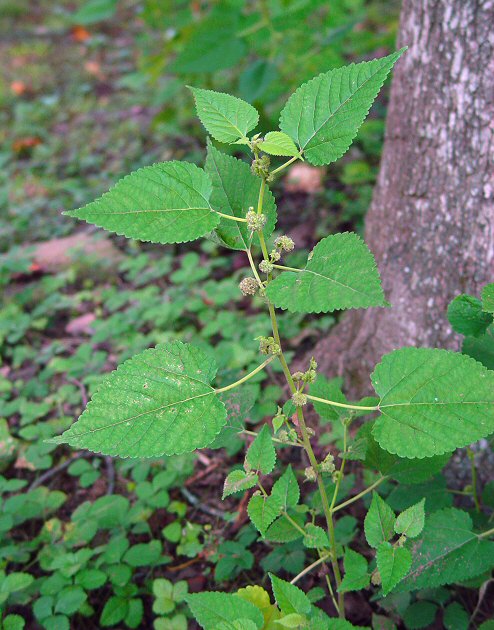Fatoua villosa (Thunb.) Nakai
Mulberry Weed

Introduced
CC = *
CW = 0
MOC = 8
© DETenaglia
Fatoua villosa (Thunb.) NakaiMulberry Weed | |
 |
Introduced CC = * CW = 0 MOC = 8 |
© DETenaglia |
|
Family - Moraceae Habit - Taprooted annual forb, monoecious, the sap milky or not. Stems - Ascending to erect, to 45 cm, densely and minutely hairy, sometimes becoming nearly glabrous with age.
Leaves - Alternate, simple, petiolate, stipulate. Petiole 0.8-6.0 cm long, minutely hairy. Blades 1-10 cm long, 0.8-7.0 cm wide, triangular-ovate, unlobed, 3-veined from the base, angled or tapered to a sharply pointed tip, truncate to shallowly cordate at the base, the margins scalloped or bluntly toothed, upper surface dark green, often somewhat roughened and with scattered, inconspicuous, appressed hairs, the undersurface pale green, roughened, hairy along the veins, or sometimes somewhat felty to the touch.
Inflorescence - Axillary, dense, hemispheric clusters, with staminate and pistillate flowers contained in opposite sides of the same cluster.
Flowers - Staminate flowers with the calyces 1.0-1.2 mm long, 4-lobed to below the midpoint, the lobes broadly elliptic-ovate and concave, glandular- and nonglandular-hairy. Pistillate flowers with the calyces 1-2 mm long, deeply 4-lobed, the lobes ovate to broadly elliptic-ovate and somewhat concave, glandular- and nonglandular-hairy, the style 1, attached laterally, unbranched (usually with a vestigial outgrowth representing an abortive second branch near its base), the stigma linear.
Fruits - Contained in dry, brown, dense hemispheric clusters 0.4-0.6 cm long and 0.6-1.0 cm wide, the individual achenes depressed-ovoid, bluntly 3-angled. Flowering - August - October. Habitat - Upland forest margins, lawns, gardens, greenhouses, open disturbed areas. Origin - Native to tropical Asia. Lookalikes - None when in flower. Vegetatively the plant resembles mulberry (Morus spp.) and some members of the Urticaceae (e.g. Boehmeria, Laportea). Other info. - This tropical weed is currently uncommon in Missouri, restricted to a handful of scattered Missouri counties. Beyond Missouri it is found in most states within the eastern U.S., also in west coast states, but in highly scattered fashion. The plant was first reported in Missouri in 1972 as a greenhouse weed, and is still usually found in association with bedding plants. The seeds appear to be efficiently transported in bedding soil, though populations which are spread in this fashion often do not persist. The plant is identified by its alternate, mulberry-like leaves and distinctive axillary inflorescences. References disagree on the nature of the sap, whether milky or not, possibly indicating variability or an intermediate condition (cloudy rather than either fully clear or thick and creamy). Fruits of mulberry weed are explosively dehiscent, ejecting seeds for distances of a few feet. Photographs taken off Lee Rd 54, Lee County, AL., 8-18-04 (DETenaglia); also in St. Louis, St. Louis County, MO, 7-23-2015; and at East Central College, Franklin County, MO, 7-30-2024 (SRTurner). |